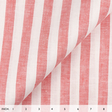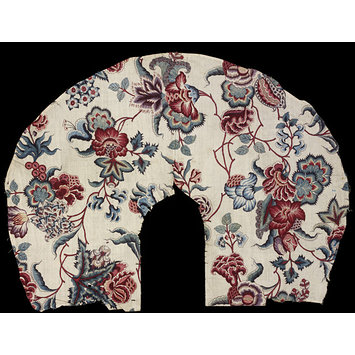This is a long title. I want to share my thinking and compromises essential when trying to do reproductions of historical clothing. To more explain myself I will talk about the difference of quality between actual ressources and the one of the 18th century.
I did a point by point to stay focus on the topic.
1- Fiber origins
This is the first thing that I look. Fabric must be 100% natural and come from fibers that where available in the 18th century. I so no to synthetic fibers.
To avoid absolutely:
Polyester, vinyle, acetate and artificials fibers. they might have other names, I do not know them all. Historical costume is made of many layers. Artificial fibers might be cheap but it does not breathe. Greenhouse effect happens when wearing only one layer of artificial fibers, so 3-4 layers made people suffocate. Moreover, these fibers look often cheap, even with an historically accurate pattern. Using artificial fibers contributes to the spreaded opinion that clothing were really hot in older time for the public and people wearing it.
OK but not historical:
I mean artificial natural fibers. Bamboo and viscose are example. The fibers are natural but the process to made it into thread is chemical. Since the technologie were not available at the time, they are not historical but they breathe. So they can be a compromise.
Historical fibers:
They are natural. The choice will depend of the character you want to interpret. Wool, linen and hemp for working classes silk and cotton for healthy people. When I choose fabric I am wary about mixed fabric. For example, I won't choose a blend of silk and cotton voile for a neckerchief because I do not know if mixed fibers was a thing and if it was blended in the same way of hte fabric I have in my hands.

Wool of sheep
I will not go into too much technical details. It is the way of the thread are crossing to change the apparence of clothing.
Vocabulary is wide today and then. Knowing what is what is a real challenge. The challenge of associate the historical name and the modern one is a challenge that I have not finish and that I may never finish.
Knit, voile, taffeta, velvet, damask, brocade, serge... All these words describe a different way to assemble threads together to make fabric.
For example, a knit of cotton will be good for stocking but never for a shift.
Silk knitted stocking, satin silk garter, linen petticoat
3- Quality of thread
Today's natural fabrics, I think about linen and silk, have more often ''defaults'' in the threads, like little bumps. The best example that I have in mind is silk dupionni but it is found often in modern linen caneva (I'm not sure about that name fabric)

This bumps are because the way of thinking did change. Mercantilism of the 18th century had been changed by industrial capitalism. A special thank to Cathrin Davis who still help me to make the differentiation.
18th century, natural fibers were more selected to make diverses quality of product but generally superior of todays. That process reduces the bumps finding into the fabric. Those bumps in fabrics where considered of bad quality. Mercantilism assured products of quality and by paying crafters adequately in fonction of the products made.
Today to save on money industrials try to use all the material of the fiber. That reduce the quality of thread and then the fabric. Another way to reduce cost is replace crafters by machines. The result of it is that there is more bumps in the fabric. Finding a linen fabric today that does not have these bumps is today something really hard, almost impossible, but is was easy in the 18th century. So, even if it is hard to believe, fabric quality of natural fabrics is way cheaper today then it was in the 18th century. Planned obsolescence of everyday objects is for something. In other words, objects today are made to be thrown after a determined period of time. So we can buy new one.
Dupionnis now... If today silk dupionni is aesthetic, it wasn't in the 18th century. People that would have been able to buy silk would have refuse those bumps on silk. Why buy an expensive fiber if it looks rustic and neglected?
There is an exemple shown in a German Museum of a 18th century clothing made with this type of silk. For the hundreds of others silk clothing from that period that survived until now and shown in painting, may I underline that it is an exception.
Credit photo: Freya Hourani
There is may be a more specific term for that. Again, linen fabric are today weave more loosely than in the 18th century. It's possible to find some that the weave is as tight as in the 18th century but it is really hard to find and when found it is really expensive. (60$ by meter for a shift that will be covered, it hurts the wallet)
Density and quality of thread will give the weigh to the fabric.
5- Fabric design
It applies to all fabric that are not plain. This point is so wide to explain that it could have it's own article.
5.1- Stripes
18th century stripes are only made by changing the color thread during the weaving process. They were never printed. I don't know exactly when technology made it print so affordable to be able to print stripe. Stripes has to be uniform, or symmetrical and not random.
5.2- Patterns
Patterns are easy way to make mistakes. To begin the reflexion about fabric design I highly suggest this article of couturière parisienne.
5.2.1- Brocades et Damas
The pattern is made by the way the threads are weaved.
An example of Silk damas ici.
5.2.2- Embroidery
Do I really need a definition here? In doubts, embroidery is a technic where stitches recovers a piece of fabrics to make a pattern.
5.2.3- The ''indiennes''
In the beginning, that word in french designed toiles of cotton painted and not painted. The painted ones were painted by brush or block prints. Later it was only use for the printed fabric.
The ''indiennes'' are mostly in flowers in an peticular pattern. And the patterns evolved during the 17th and 18th century.
There is a lot still to discover about ''indiennes'' according to me. They were offcially banned of the France country until Louis XIV. So it was smuggling material. Despite of that there is traces of those fabrics in France and New France in inventories.
Victoria and Albert Museum
For french speaker that would have lost themself on that article and not on the french one, this article is about ''indienne''s in France in the 18th century.
If you are in Québec near Montréal, there is an interactive and interesting exposition in Fort Chambly about smugglers. They talk a little about ''indiennes''.
So I'm not very legal for the period for wearing an indienne dress!
There is the an overview of the questions I'm asking myself before buying a fabric for confection. It's a a beautiful problem to want to represent adequately the century of Enlightenments.
Mlle Canadienne
P.S. In french, an interesting article about technical aspect of fabric: http://100associes.free.fr/Expo4/ExpoTemp4.html












Aucun commentaire:
Enregistrer un commentaire